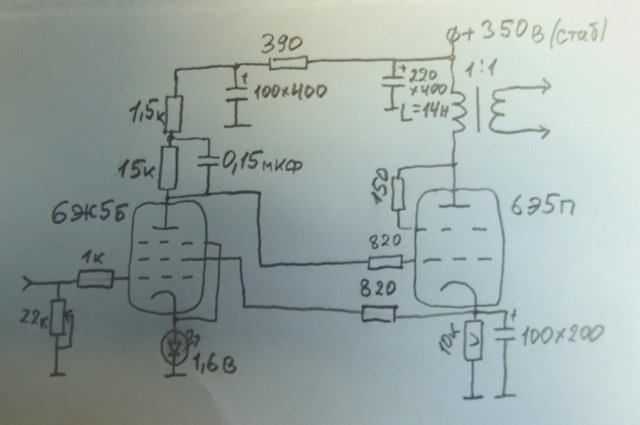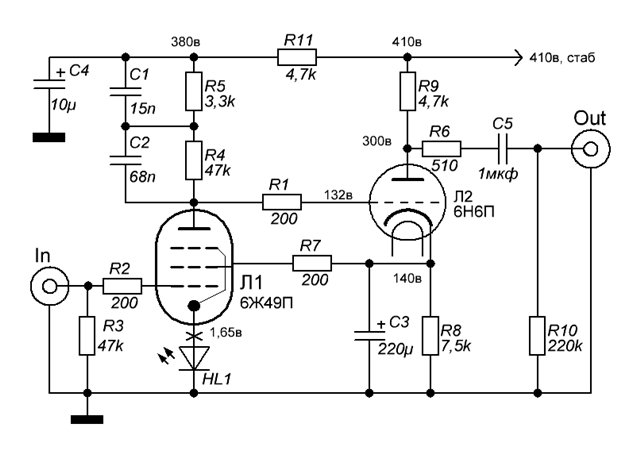|
Posted by Romy the Cat on
03-01-2010
|
|
fiogf49gjkf0d Guys from a Russian audio site come up with an idea of MM corrector that I find very interesting, take a look – it is self-explanatory. The firs tube is Russian equivalent of 7788. The second is “my” 6E5P, though I would use 7721 – sounds better in output if no drive in required.

|
|
|
|
Posted by cv on
03-02-2010
|
|
fiogf49gjkf0d Hi Romy
How very strange you mention this... Dave and Jeffrey have been working with a somewhat similar concept.
The design you have doesn't look right - it's missing a time constant; you need another cap there. Where did you find this schematic?
|
|
|
|
Posted by Romy the Cat on
03-02-2010
|
|
fiogf49gjkf0d
Nope, it does not miss anything. They offset the 75msec in input using the inductance of cartage’s coil (I quess they do not use MC). Below is the original thread. You need to buy a chocolate cake and to do a foot massage to your Russian mistress to read it. In personaly I do not see a lot of useful written at this thread. I think the idea is well highlighted and the rest is secondary.
http://hiend.borda.ru/?1-7-0-00000010-000-10001-0
If I had any interests in phonostages then I would prototype the concept to see how it works. But what is the point – the “End of the Life Phonostage” will blow it up anyhow… Again… The caT
|
|
|
|
Posted by cv on
03-03-2010
|
|
fiogf49gjkf0d I don't see how the cartridge inductance is doing anything as far as that schematic goes.
There's another thing *very* wrong with it as well, but as you're not going to pursue it, we can leave it at that.
|
|
|
|
Posted by Romy the Cat on
03-03-2010
|
|
fiogf49gjkf0d  cv wrote: cv wrote: | I don't see how the cartridge inductance is doing anything as far as that schematic goes.
There's another thing *very* wrong with it as well, but as you're not going to pursue it, we can leave it at that. |
|
Possible, I posted it more as an idea not as source for replication. In that site they claim that they built it “as is” and that work and measure fine. It is irrelevant what they claim, even thigh it might be true. The concept is still elegant and different and this is all that sounds. Sure there are no claims about sonic advantages of this way…
The Cat
|
|
|
|
Posted by Romy the Cat on
03-03-2010
|
|
fiogf49gjkf0d

|
|
|
|
Posted by cv on
03-04-2010
|
|
fiogf49gjkf0d That makes more sense, though I must admit, Dave corrected me regarding how the first scheme might work (I had forgotten MM cartridges had such high inductances).
|
|
|
|
Posted by Romy the Cat on
03-04-2010
|
|
fiogf49gjkf0d Yes, I knew that you were not accurate with your assumption that MM cannot run 75mSec offset.I am not a big fun of this method as no sane person would use MM cartridges. However, what I find is very attractive in this phonocorrector is to employ SOME of those ideas for DSET applications and to filter DSET via plate voltages on driver of power stages. I do not care about the phonostages but I think for DSET it might open some room. You for instance would like to write a line level filter but you too hectic about keeping the grid impedances low and input impedance high. Here is an option of massaging the plate voltage…The Cat
|
|
|
|
Posted by Paul S on
03-04-2010
|
|
fiogf49gjkf0d This appears to put the internal values of its gain stages into play, which in turn appears to cut the signal path parts count, all right. Since we are not given the (presumed "dedicated") cartridge H, did anyone run reverse numbers to see if this path also includes the tubes' Miller capacitance?
I forget which tubes they used as I post this, but how much does a design like this depend on the absolute stability of the gain stages, ie, how much slop is built in, or where would one go to tweak it without effing up turnover?
Overall, is there sufficient isolation here, or is there classic tank circuit co-dependency/bleed-through?
...put a DACT PS on that puppy...
Paul S
|
|
|
|
Posted by cv on
03-04-2010
|
|
fiogf49gjkf0d Hello Paul,
The first stage is a pentode, so the Miller cap is negligible. As for the other things you mentioned, there is a detailed exploration, which covers some of your points, by Dave Slagle at:
http://www.intactaudio.com/forum/viewtopic.php?t=1026
I do highly recommend LTSpice (free download) for answering such engineering-type questions... plenty of tube-oriented info and fairly accurate tube models available from the above website. Takes a wee bit of time to setup but well worth it.
best,
cv
|
|